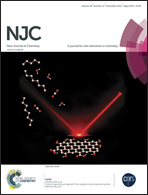Spruce branched α-Fe2O3 nanostructures as potential scaffolds for a highly sensitive and selective glucose biosensor
Abstract
This paper presents the fabrication of a highly sensitive and selective glucose biosensor based on spruce branched α-Fe2O3 nanostructures. The spruce branched α-Fe2O3 nanostructures were synthesized by a hydrothermal process and characterized by using various techniques. The fabricated glucose biosensor exhibited a very high and reproducible sensitivity of 85.384 μA mM−1 cm−2 with a response time of less than 2 s and a detection limit (based on S/N ratio) of 1 μM. A linear dynamic range from 0.003–33 mM with a correlation coefficient (R2) of 0.9996 was observed for the fabricated biosensor.


 Please wait while we load your content...
Please wait while we load your content...